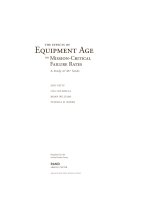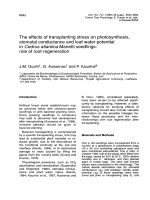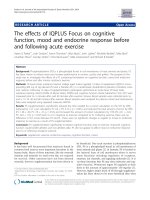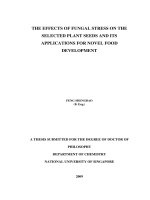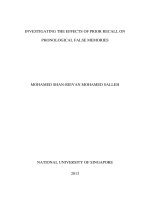The effects of authentic leadership on symmetrical internal communication and employee organization relationships
Bạn đang xem bản rút gọn của tài liệu. Xem và tải ngay bản đầy đủ của tài liệu tại đây (1.42 MB, 119 trang )
MINISTRY OF EDUCATION AND TRAINING
UNIVERSITY OF ECONOMICS HO CHI MINH CITY
----------
HOANG THI KIM QUY
THE EFFECTS OF AUTHENTIC LEADERSHIP ON
SYMMETRICAL INTERNAL COMMUNICATION AND
EMPLOYEE-ORGANIZATION RELATIONSHIPS
MASTER OF BUSINESS
Ho Chi Minh City - 2017
MINISTRY OF EDUCATION AND TRAINING
UNIVERSITY OF ECONOMICS HO CHI MINH CITY
----------
HOANG THI KIM QUY
THE EFFECTS OF AUTHENTIC LEADERSHIP ON
SYMMETRICAL INTERNAL COMMUNICATION AND
EMPLOYEE-ORGANIZATION RELATIONSHIPS
Major: Business Administration (Research)
ID: 60340102
MASTER OF BUSINESS
SUPERVISOR: DR. TRAN MAI DONG
Ho Chi Minh City – 2017
ACKNOWLEDGE
First of all, I would like to express my gratefulness to Dr. Tran Mai Dong for his
intensive support, introduction, valuable suggestions as well as his encouragement
over six months of doing my research. His professional knowledge and his
experiences inspire me a lot and help me get more motivation to conduct and
complete my study.
Additionally, I would like to give a sincere thank to all my friends, who are
working for aviation organizations in Ho Chi Minh city for their intensive support
when I collected the data. I am so grateful to all of you.
Last but not least, my warm thanks to my family who always stood by me,
support for me to complete this study.
Thank you for giving me your strength. I love all of you!
ABSTRACT
The definition of leadership and the role of effective leadership in organizations
has been investigated by many scholars over the world. However, the perception of
leadership in Viet Nam remains limited. Obviously, Vietnamese leaders have not
identified the important role of applying an effective leadership style in enhancing
organizational performance. Moreover, they have not had a sufficient perception of
employee’s importance and focused on how to maintain a long-term relationship
with their subordinates. Thus, a further research need to conduct to prove the crucial
role of leadership in organizations and how the leadership style affects the company
performance in terms of the quality of employee-organization relationships.
The purpose of this current study is to examine empirically the impacts of
authentic leadership on symmetrical internal communication and employeeorganization relationships. This research was conducted through a two-phase study,
including the qualitative study and main quantitative research. After interviewing
deeply with six participants, who come from different positions with various
backgrounds in a wide range of aviation organizations to get their opinions about
research problems and modification for scale items, a final single survey was
achieved. Then, this survey was delivered to Vietnamese staffs from the aviation
industry in Vietnam. The data were collected based on a sample size of 140
participants by the convenient sampling technique. Moreover, structural equation
modeling (SEM) indicated that authentic leadership positively affects EORs both
directly and indirectly, through symmetrical internal communication. Also, the
study provides theoretical and practical implications as well as suggested directions
for future research. On the other hand, some limitations were mentioned in this
study.
Keywords: Leadership, Authentic leadership, Symmetrical internal communication,
Employee-organization relationships.
TABLE OF CONTENTS
ACKNOWLEDGE
ABSTRACT
TABLE OF CONTENTS
LIST OF ABBREVIATIONS
LIST OF TABLES
LIST OF FIGURES
CHAPTER 1: INTRODUCTION ............................................................................1
1.1. Research background and research problem ....................................................1
1.2. Research objectives ..........................................................................................4
1.3. Scope and subject of the study..........................................................................4
1.4. Research methodology......................................................................................5
1.5. Research significance .......................................................................................6
1.6. Thesis structure .................................................................................................6
CHAPTER 2: LITERATURE REVIEW ................................................................8
2.1. Literature Review .............................................................................................8
2.1.1. Leadership ..................................................................................................8
2.1.2. Leadership theories.....................................................................................9
2.1.3. Authentic leadership (AL) ........................................................................13
2.1.4. Symmetrical internal communication (SIC) ............................................15
2.1.5. Employee – organization relationships (EORs) .......................................16
2.2. Hypothesis development .................................................................................17
2.2.1. Authentic leadership and symmetrical internal communication ..............17
2.2.2. Authentic leadership and employee-organization relationships ..............19
2.2.3. Symmetrical communication and employee-organization relationships .21
2.3. Research model ...........................................................................................22
2.4. Chapter summary ............................................................................................22
CHAPTER 3: METHODOLOGY .........................................................................24
3.1. Research paradigm..........................................................................................24
3.2. Research procedure .........................................................................................25
3.3. Measurement scale ..........................................................................................26
3.3.1. Authentic leadership scale (AL) ...............................................................26
3.3.2. Symmetrical internal communication (SIC) ............................................28
3.3.3. Employee-organization relationships (EORs) ..........................................28
3.4. Qualitative study .............................................................................................29
3.4.1. Sampling ...................................................................................................29
3.4.2. Data analysis technique ............................................................................31
3.4.3. Qualitative findings ..................................................................................32
3.4.3.1. Qualitative results ..............................................................................32
3.4.3.2. Modified scale items ..........................................................................32
3.5. Main quantitative study ..................................................................................33
3.5.1. Sampling ...................................................................................................34
3.5.2. Data analysis techniques ..........................................................................35
3.6. Chapter summary ............................................................................................36
CHAPTER 4: DATA ANALYSIS .........................................................................37
4.1. Respondent demographics ..............................................................................37
4.2. Evaluate the measurement by CFA ................................................................38
4.2.1. CFA result of Authentic leadership ..........................................................38
4.2.2. CFA result of Symmetrical internal communication ...............................41
4.2.3. CFA result for Employee-organization relationships ..............................42
4.3. The saturated model ........................................................................................44
4.4. Structural model (The hypothesized model) ..................................................45
4.5. Results of testing the hypotheses ....................................................................47
4.6. Bootstrap method ............................................................................................48
4.7. Chapter summary ............................................................................................49
CHAPTER 5: CONCLUSIONS, IMPLICATIONS AND LIMITATIONS ......50
5.1. Discussion .......................................................................................................50
5.2. Implication of research findings .....................................................................53
5.2.1. Theoretical implications ...........................................................................53
5.2.2. Practical implications...................................................................................54
5.2.3. Limitations and directions for further research ........................................55
5.2.3.1. Limitations .........................................................................................55
5.2.3.2. Directions for future research ............................................................56
5.3. Conclusion ......................................................................................................57
REFERENCES ........................................................................................................58
APPENDICES .........................................................................................................69
Appendix 2.1: Review of definitions of authentic leaders and authentic leadership
...............................................................................................................................69
Appendix 3.1: English Qualitative Interview Questions ......................................77
Appendix 3.2: Vietnamese Qualitative Interview Questions ...............................81
Appendix 3.3: Data transcript of Staff 1 (English version) ...................................85
Appendix 3.4: Data transcript of Staff 1 (Vietnamese version) ............................92
Appendix 3.5: The qualitative research findings ...................................................98
Appendix 3.6: Questionnaire (English Version) .................................................102
Appendix 3.7: Questionnaire (Vietnamese Version) ...........................................105
LIST OF ABBREVIATIONS
AMOS
Analysis of Moment Structures
CFA
Confirmation Factor Analysis
SPSS
Statistical Package for the Social Sciences
AL
Authentic leadership
SIC
Symmetrical internal communication
EORs
Employee-organization relationships
SEM
Structural Equation Modelling
CR
Composite reliability
AVE
Averaged variance extracted
EFA
Exploratory Factor Analysis
C.R
Critical value ratios
LIST OF TABLES
Table 3.1. Scale items of Authentic leadership .........................................................27
Table 3.2. Scale items of Symmetrical internal communication ..............................28
Table 3.3. Scale items of Employee – organization relationships ............................29
Table 3.4: Participants’demographics .......................................................................30
Table 4.1. Demographic profile ................................................................................38
Table 4.2. Summarized of CR, AVE and Cronbach’α (Authentic leadership ..........40
Table 4.3. Correlation of Authentic leadership .........................................................41
Table 4.4. Summarized of CR, AVE and Cronbach’α ..............................................42
Table 4.5. Summarized of CR, AVE and Cronbach’α (EORs) ................................43
Table 4.6. Correlation of Employee-organization relationships ...............................44
Table 4.7. Constructs Correlation .............................................................................45
Table 4.8. Results of testing the hypotheses .............................................................47
Table 4.9. Regression Weights (bootstrap standard errors) ......................................49
LIST OF FIGURES
Figure 2.1. Research model .......................................................................................22
Figure 4.2. CFA of Symmetrical internal communication........................................41
Figure 4.3. CFA of Symmetrical internal communication........................................43
Figure 4.4. SEM analysis results for saturated model...............................................44
Figure 4.5. The hypothesized structural model .........................................................46
Figure 4.6. Results of testing the hypotheses ............................................................47
1
CHAPTER 1: INTRODUCTION
In this chapter, the critical role of leadership style in relationship between
internal communication and the quality of employee-organization relationships was
demonstrated, particularly in an uncertain business environment as today. In
addition, this chapter illustrated the research problem in the Vietnamese context
with dimensions adapted to the specific Vietnamese culture. Moreover, the purpose,
scope and significance of the study were also introduced.
1.1. Research background and research problem
Internal communication is always a vital process by which employees share
information, targets, relationships, make meaning, establish organizational culture
as well as an organizational value (Berger, 2008). Internal communication is
considered as a fundamental factor of modern organizations. Numerous scholars
have suggested that effective internal communication plays a critical role in
developing positive follower attitudes such as trust, organization's commitment (Jo
and Shim, 2005), job satisfaction (Gray and Laidlaw, 2004), identification with an
organization
(Smidts
et
al.,
2001)
and
positive
employees-organization
relationships. These attitudes and behaviors, in turn, increase productivity, improve
performance, build greater relationships with other stakeholders. Recognizing the
importance of employees in achieving organization's successes, researchers have
conducted broadly studies exploring the drivers of internal communication
effectiveness. Dozier et al., (1995); Grunig et al., (2002) suggested that a
participative organizational culture, an organic structure, gender equality and power
symmetry are the key factors that facilitate the organization’s internal
communication. However, in recent years, researchers have noticed about the
influences of leadership on internal communication. Leader’s communication styles
are one of the main contextual factors in the internal communication system in the
organization (Whitworth, 2011; Men, 2014), affect follower attitudes and behaviors
2
(Holladay and Coombs, 1993; Berger, 2008; Kim and Rhee, 2011; Men and Stacks,
2013, 2014). Furthermore, leaders enable context and determine the degree in which
internal communication takes place. Yukl (2006) defined leadership as the process
of influencing followers. Leadership at different organizational levels directly or
indirectly determines structural forms, organizational culture and climate, power
distribution, and communication. Different types of leadership advocate different
communication styles to influence followers, and thus constitute a major component
of the internal communication system (Whitworth, 2011). Also, leader’s
communication competence, management styles, leader’s communication behaviors
is closely connected to employee outcomes, the quality of employee-organization
relationships. On the other hand, studies related to the impact of leadership styles on
internal and external communication effectiveness have limitations. Most previous
studies considered the connection between internal communication and general
leadership style. Similarly, a noticeable role of specific leadership style in that
relationship has not yet to been proved broadly in various contexts in research,
involving authentic leadership which embraces considerable effects on the internal
communication system in an organization (Men and Stacks, 2014). According to
George et al., (2007), authentic leaders demonstrate a passion for their purpose, lead
with their hearts as well as their heads and their values are practiced consistently.
Previous scholars suggested that authentic leaders establish long-term, meaningful
relationships and have the self discipline to get results. They know who they are and
become true to themselves. Thus, they proactively foster positive environments
where their employees can easily conduct two way communication, including
feedback about their managers, whether it is good or not. Further, leaders with
authentic leadership openly sharing information and expressions of one’s true
thoughts and feelings while trying to minimize displays of inappropriate emotions
(Kernis, 2003). These leaders don’t hesitate to disclose information related to
making decisions or any issues happening within the organization which employees
have right to know and respond. Besides that, authentic leaders recognize that
3
leadership is not about their success or about getting loyal subordinates to follow
them (George et al., 2007). Thanks to their character, authentic leaders are noted to
foster the long-term relationship with their subordinates. Moreover, they act in
harmony with their words as well as deep personal values and convictions to build
credibility and win the respect and trust of followers (Walumbwa et al., 2008).
These things make a significant contribution to employee engagement and improve
the quality of employee-organization relationships...Although, authentic leadership
generates numerous positive outcomes, most studies are conducted in western
countries which charactered by individualism value, low-power distance... (Gardner
et al., 2011). In the view of these gaps, the current study makes an important
contribution to fulfill.
Additionally, few empirical studies have directly examined the effects of internal
communication with employees-organization relationships (Kim, 2007; Kim and
Rhee, 2011; Shen, 2011; Waters et al., 2013; Men, 2014; Men and Stacks, 2014;).
In contrast, recent researchers have tested the linkage between internal
communication and organization performance (Broom and Dozier, 1983; Dozier,
1990; Grunig et al., 2002; Yates, 2006; Meng and Berger, 2012; Michaelson and
Stacks, 2017) as well as the influences of leadership styles, particularly authentic
leadership and top manager’s communication forms of effective internal
communication,
employee
engagement,
positive
employee-organization
relationships (Men and Stacks, 2014; Men 2015; Kang, 2017). Leadership styles,
excellent communication have significantly proved to nurture better relationship
between employees and their organization (Kress, 2005; Lockswood, 2007; Men
and Stacks, 2014; Kang, 2017).
The
studies
on
the
relationship
amongst
leadership
styles,
internal
communication, the quality of employee-organization relationships have limitations
in Vietnam’s current business context. Furthermore, Vietnamese enterprises’s
perceptions of these strategic problems have been misunderstood (Vu, 2013). They
4
have not determined the importance of effective internal communication operation
in enhancing company performance in the future, specifically, top manager’s roles
in applying leadership and management perspectives to work on and increase
employee commitment through effective internal communication system in the
organization (Vu, 2013). Thus, this study investigates the effects of authentic
leadership on symmetrical internal communication and employee-organization. The
aim of study is to examine authentic leadership scale (AQL) of Neider &
Schriesheim (2011), Grunig’s internal communication scale in Vietnam and
measure the linkage between these two concepts and the quality of employeeorganization relationships. The findings provide significant implications for
communication professionals and organizational leaders on how to develop the best
practices of internal communication and positive employee attitudes and behavior
that contribute to organizational effectiveness.
1.2. Research objectives
The purposes of this study are:
To investigate the impacts of authentic leadership on symmetrical
internal communication, direct and indirect effects of this leadership
style on employee-organization relationships.
To adapt the authentic leadership scale, symmetrical internal
communication, employee-organization relationships to Vietnamese
context.
To provide management implications to enhance the positive
influences of internal communication on employee outcomes.
1.3. Scope and subject of the study
Subject of the study: The effects of authentic leadership on
symmetrical internal communication and employee-organization
relationships.
5
The scope of the study: The research is conducted in a range of
medium – large companies doing business in the aviation sector in
Ho Chi Minh city. This one of specific fields, making a significant
contribution to the development of the Vietnamese economy.
1.4. Research methodology
To accomplish the aims of this research, two steps of the study were carried out:
a qualitative study and a quantitative study.
Qualitative study
The purpose of this step was to adjust the items closing to features of Vietnam
and made the measurement scale become more proper for Vietnam context and easy
to understand for respondents. Moreover, because of the particularity of research
sample, expert perspectives on research population are approached. Thus, the indepth interviews were conducted with six target participants six who were selected
from different positions, including one senior manager, two middle managers, one
supervisor and two employees. They came from the aviation organizations in Ho
Chi Minh City.
Quantitative study
In the quantitative research, 140 participants working in the aviation sector in Ho
Chi Minh City were recruited for the survey by convenient sampling techniques. A
self-administered questionnaire with Likert five-point scale that measures the
constructs of the study is developed on the effects of authentic leadership on
symmetrical internal communication and employee-organization relationships
literature review. Subjects were asked to rate their agreement with each item on a
five-point Likert scale ranging from 1 (strongly disagree) to 5 (strongly agree). All
of questionnaire items were taken from previously valid scales. Data related to
gender, education, job status of respondents was measured by nominal scale,
subject’s ages were measured by ordinal scale. Descriptive statistics for the entire
6
sample were done with Statistical Package for SPSS 20. To test the measurement
model and structural equation modeling (SEM), Analysis of Moment Structures
(AMOS) 20 was used for data analysis.
1.5. Research significance
The thesis results supply some useful implications to both theoretical and
practical aspects in Vietnamese context.
Theoretical contribution
The findings of this study help to adjust the authentic leadership scale and
symmetrical internal communication scale in Vietnamese context. Also, employing
these measurement scales will bring more advantages for future research.
Additionally, the research provides opportunities to test the direct and indirect
effects of authentic leadership on employee-organization relationships respectively.
Practical contribution
Based on the research results, some useful management implications were
suggested to help Vietnamese managers in the Aviation field understand deeply
about the importance of the authentic leadership in providing internal
communication effectiveness in order to boost employee satisfaction and increase
their engagement, improve employee-organization relationships as well as the
followers’s positive attitudes.
1.6. Thesis structure
The thesis is divided into five chapters:
The first chapter introduces the subject matter and provides the
problem, the research objects, scope and significance of the study.
The second chapter reviews and synthesizes the theories in the
literature of research’s concepts, including the authentic leadership,
symmetrical
internal
communication
and
employee-organization
7
relationships. This chapter also describes the conceptual model and
hypotheses.
In the third chapter, a methodology is presented to appraise
measurement scale. Then the research design and data collection process for
this study are explained.
Chapter four presents the results of data analysis and analyzes them
for their relevance to the research objects or hypotheses.
The final chapter, chapter 5 shows conclusions, implications and
limitations of the thesis and provides contributions for future research.
8
CHAPTER 2: LITERATURE REVIEW
This chapter mainly provided the theories which were proposed by many
scholars in academic field and were related to all the concepts and research model.
Beginning with an introduction about leadership theories and the link to a key
leadership style authentic leadership which was undertaken in this research. Next,
the definitions of the constructs, including the authentic leadership, internal
communication, employee-organization relationships were discussed and then the
relationships among those concepts conducted by previous studies were also
developed for proposing a conceptual model and hypotheses.
2.1. Literature Review
2.1.1. Leadership
Leadership is one of the critical factors determining the success of an
organization and attain increasing interest in the fields of management, business,
marketing. However, studies on leadership in the public relation, social
relationships are emerging in recent decades (Bass and Avolio, 1994; Aldoory and
Toth, 2004). Yukl (2006) and Northouse (2004) noted that, leadership as the
interaction between the leaders and their subordinates and influencing others to
know and understand what must be done and the ways how to do it, and the process
of facilitating individual and collective efforts to accomplish shared objectives.
Leadership is to seek and establish methods in order to motivate people, provide
them directions to achieve their goals (Amirul and Daud, 2012).
House (2004) defined that leadership is an individual‘s capability in influencing,
motivating, encouraging other people to contribute organization’s success and
effectiveness of which they are members. Leaders are suggested to create a fair
working environment. Within this condition, leaders and their subordinates openly
share information, messages, emphasize on reciprocity, responsiveness, two-way
communication. Similarly, Bass (1985, p. 20) argued that, a leader is “one who
9
motivates us to do more than we originally expected to do”. He suggested that this
motivation could be attained by raising the perception about the importance of work
performance and ways how to reach it.
2.1.2. Leadership theories
Viewing about thousands of studies on leadership, over more than 1000 years,
Stogdill (1974) found that the number of people giving definitions of leadership is
as much as scholars attempting to clarify these phenomena. Riggs (2001, p. 5)
revealed that “Throughout the world, leadership is generally perceived as something
we need more of, while at the same time it is generally misunderstood. There are at
least 100 definitions of leadership.”. According to the length of history, researchers
in leadership field have struggled with the question of leadership definitions and
leadership development for many years and made significant contributions to
science of leadership (Northhouse, 2013; Tran et al., 2015). The field of leadership
studies has changed over years because of a dynamic business environment. Thus,
Avolio et al., (2009, p. 422) declared that “Today, the field of leadership focuses not
only on the leader, but also on followers, peers, supervisors, work setting/context,
and culture, including a much broader array of individuals representing the entire
spectrum of diversity, public, private, and not for profit organizations, and
increasingly over the past 20 years, samples of populations from nations around the
globe”. Likewise, Ortega (2017) noted that the leadership have approached in a
variety of ways over the years, beginning with the Great Man Theory, which is seen
as old – fashioned now to that of the closely related “leadership traits” theory, to the
emerging
leadership
theories
of
the
transactional
leadership
and
the
transformational leadership styles, ethical, servant, authentic, intentional, and
collaborative leadership philosophies and management practices. Besides, previous
scholar also paid significant attention to the positive outcomes of leadership in
various contexts, involving countries, organizations, individuals (Ortega, 2017). In
this section, a short review about literature on leadership theories and approaches is
demonstrated to get a clear perception of an overall picture of leadership theories
10
and diverse development during the last decades. The aim of this approach is to
reveal the reasons why the author decides to choose authentic leadership to discuss
in the current study.
a) Trait approach
According to Tran et al., (2015), Dinh et al., (2013) the trait approach is one of
the first earliest systematic attempts to study leadership. Modern leadership research
in early 20th century witnessed a dramatic rise thanks to the trait theory, with
scholars noted that the leadership effectiveness is predicted through demographic
and physical attributes, competencies, and personality characteristics (Stogdill,
1974; Bass, 1990). Traits were proved to distinguish between leaders and nonleaders by concentrating on personal qualities and characteristics (Hernandez et al.,
2011). This approach developed an assumption that traits produce patterns of
behavior that are consistent across situations. It means that, leadership attributes are
determined to be enduring characteristics that people are born with, stable over time
and not made. However, many researchers argued that there is small difference
between leaders and their followers in the view of personalities (Northouse, 2013;
Dinh et al., 2013). According to Hernandez et al., (2011, pp. 1165), “traits did not
emerge as sufficient predictors of leadership effectiveness, and the field of
leadership was left with a deficiency of predictors”. Additionally, the trait approach
has underestimated the impact of the situation (Northouse, 2013). Also, there has
been few systematic studies on the processes by which individuals obtain the
abilities for leadership.
b) Style approach
Style approach studies suggested that people can be trained to lead. Research
tended to behaviors of specific leaders started in the 1940s and was led by two
different studies: The Ohio State studies, the University of Michigan studies.
Similarly, Blake and Mouton's (1964) managerial grid continued pay attention to
11
this approach (Northouse, 2013; Tran et al., 2015). The research approaches focus
on two perspectives of leader’s behaviors: Task oriented behavior and relationship
oriented behavior. All together, Ohio State, Michigan research and Blake &
Mouton’s Leadership Grid found that the ideal leader is always both performance
and maintenance oriented (Katz et al., 1950; Katz et al., 1951; Katz and Kahn,
1952; Likert, 1961; Hernandez et al., 2011; Northhouse, 2013; Tran et al., 2015).
On the contrary, a number of limitations of this approach started to be considered in
the 1960s. Firstly, the relationship between the behaviors of leaders and the
outcomes such as job satisfaction and productivity have not been investigated
(Northouse, 2013). Next, because specific behaviors and actions of leaders may be
relevant and effective at a particular point of time and noticeably depend on
situational variables while at another, it could be out of the picture. Therefore, the
effect of time factor as well as situation has been ignored in this approach.
c) Situational approach
This leadership perspective proposed that universally important traits and
behaviors do not exist, and that effective leadership behavior varies from situation
to situation. According to this approach, the leaders were required to first analyze
the situation and then decide what to do. In other words, look before you lead.
Researchers have conducted and developed many models and theories of leadership
such as path-goal theory, participative leadership, contingency leadership and
situational leadership (Northouse, 2013; Tran et al., 2015). Nevertheless, by early
1980s, the situational perspective had less attention because leadership had to be
seen as almost inseparable from the management (Tran et al., 2015).
d) Modernist leadership approach
Modernist leadership approaches clarify the differences between leadership
phenomenon and management in term of enhancing subordinate’s motivation and
engagement in the leader’s cause. Northouse (2013) proposed that this perspective
12
began appearing in the mid-1980s, one of the newest leadership approach which
embraces many models and developed theories of leadership. For instance,
transformational leadership, charismatic leadership, value-based leadership,
individualized leadership, vertical dyad linkage, leader-member exchange, principle
-centered leadership, multilevel and leaderplnex, implicit leadership theories, ethical
leadership, romance of leadership, multiple linkage and influence tactics
(Yammario et al., 2005; Avolio et al., 2009; Northouse, 2013). Because of the
dynamic business environment as well as the impacts of development of science &
technology, leadership trends reckon with a lot of changes and require more
relevant leadership theories, adapt to the continuous movement of business
contexts. A new stage of leadership research is emerging.
e) Postmodernist leadership approach
In the 21st century leadership theories have seen a significant concern with a
variety of strategic approaches. Emerging research on leadership development, is
also concerned with traits or attributes (Wolff et al., 2002; Foti and Hauenstein,
2007) and experiences (Avolio et al., 2009) that predispose an individual to emerge
as a leader. Encouragingly, scholars are beginning to appreciate the effects or
outcomes of leaders by using a systematic approach (Lichtenstein and Plowman,
2009) with social contexts, such as shared leadership (Carson et al., 2007) and
virtual teams (Balthazard et al., 2009). The leadership has involved with
technology, labor, social, economic, and cultural changes as well as the needs of the
organization change to respond to the turbulence and uncertainty of the
environment. The letters and follower relationship were no longer of main concern
to the study of leadership (Clegg et al., 2011). The postmodernist have paid
increased attention to the ethical and moral values-based content of a leader’s
behavior (Dinh et al., 2013) such as level-five leadership, authentic leadership,
ethical leadership, self-leadership, electronic leadership, blue ocean leadership,
empowering leadership, servant leadership, substitutes for leadership, and cross-
13
cultural leadership (Yammario et al., 2005; Avolio and Gardner, 2005; Gardner et
al., 2011; Northouse, 2013; Dinh et al., 2013). The postmodernist perspective to
leadership and development should be integrated in further studies to identify,
leverage the advances in awareness of leadership and organization performance.
The purpose of discussion of the general picture of leadership theories and
evolution has reviewed the literature on leadership approaches and investigated the
ways in which field leadership is developing. Through this section, the perception
of leadership is deeply understood. In addition, leadership theories are built up and
applied to different periods of time, based on the development process in order to
adapt to the dynamic environment and various cultural contexts. Notably, the
models of leadership and their effectiveness is combined with certain contextual
factors. Moreover, the influences of leadership approaches in the relationship with
organization‘s outcomes need to be considered logically to determine what, how
and when leadership is operating effectively.
2.1.3. Authentic leadership (AL)
In the earliest stage of authentic leadership theory with original models of
authentic leadership, Luthans and Avolio (2003) noted that the theory arose from
the nexus of positive organizational behavior, transformational/full-range leadership
development, and work on ethical and moral perspective-taking capacity. Moreover,
they revealed that such leadership worked when “[an individual is] true to
him/herself and the exhibited behavior positively transforms or develops associates
into leaders themselves” (Gardner et al., 2011, p. 1120). Therefore, the mechanism
of influence involved role modeling and arose from the leader’s alignment of his or
her behavior with core personal values and beliefs. Since followers observed such
behavior, they were often positively affected by the leader and impacted to likewise
adjust their values and actions. Furthermore, Avolio and Gardner (2005) suggested
that authentic leadership constitute the ‘root construct’ that underlies positive forms
14
of leadership such as transformational and transactional leadership, ethical
leadership, servant leadership theories.
Although authentic leadership has been only recognized broadly in recent
decades and seen as one of emerging leadership theories, previous researchers
advanced a variety of definitions of leader authenticity or AL over time as the table
2.1 (see Appendix 2.1). Based on intensive review of the definitions, content
analysis of authentic leadership as well as the development of leadership theories in
recent studies. This current study’s conceptualization of AL was based at
Walumbwa et al., (2008). This construct involving four particular dimensions are
identified: Self-awareness refers to a leader’s understanding of how one derives
and makes meaning of the world and how that meaning making process impacts the
way one views himself or herself over time (Garner et al., 2011). This
understanding is also to present recognition of one’s strengths and weaknesses and
the multifaceted nature of the self. Through interaction with other, leader with high
self - awareness, gain valuable insight into the self through exposure to others, and
being cognizant of one’s impact on other people (Kernis, 2003). Relational
transparency involves the presentation of one’s authentic self to others. Such
behavior promotes trust through disclosures that involve openly sharing information
and expressions of one’s true thoughts and feelings while trying to minimize
displays of inappropriate emotions (Kernis, 2003). Balanced processing of
information demonstrates a leader who shows that they objectively analyze all
relevant data before coming to a decision. In addition, authentic leaders seek out
objective information even if it challenges their preexisting notions (Garner et al.,
2011). Such leaders also solicit views that challenge their deeply held positions
(Gardner et al., 2011). Finally, an internalized moral perspective refers to a leader
holding and adhering to core standards, ethical values, and principles as an act of
personal choice. Additionally, it is also an internalized and integrated form of selfregulation “guided by internal moral standards and values versus group,
organizational, and societal pressures” and “results in expressing decision making

